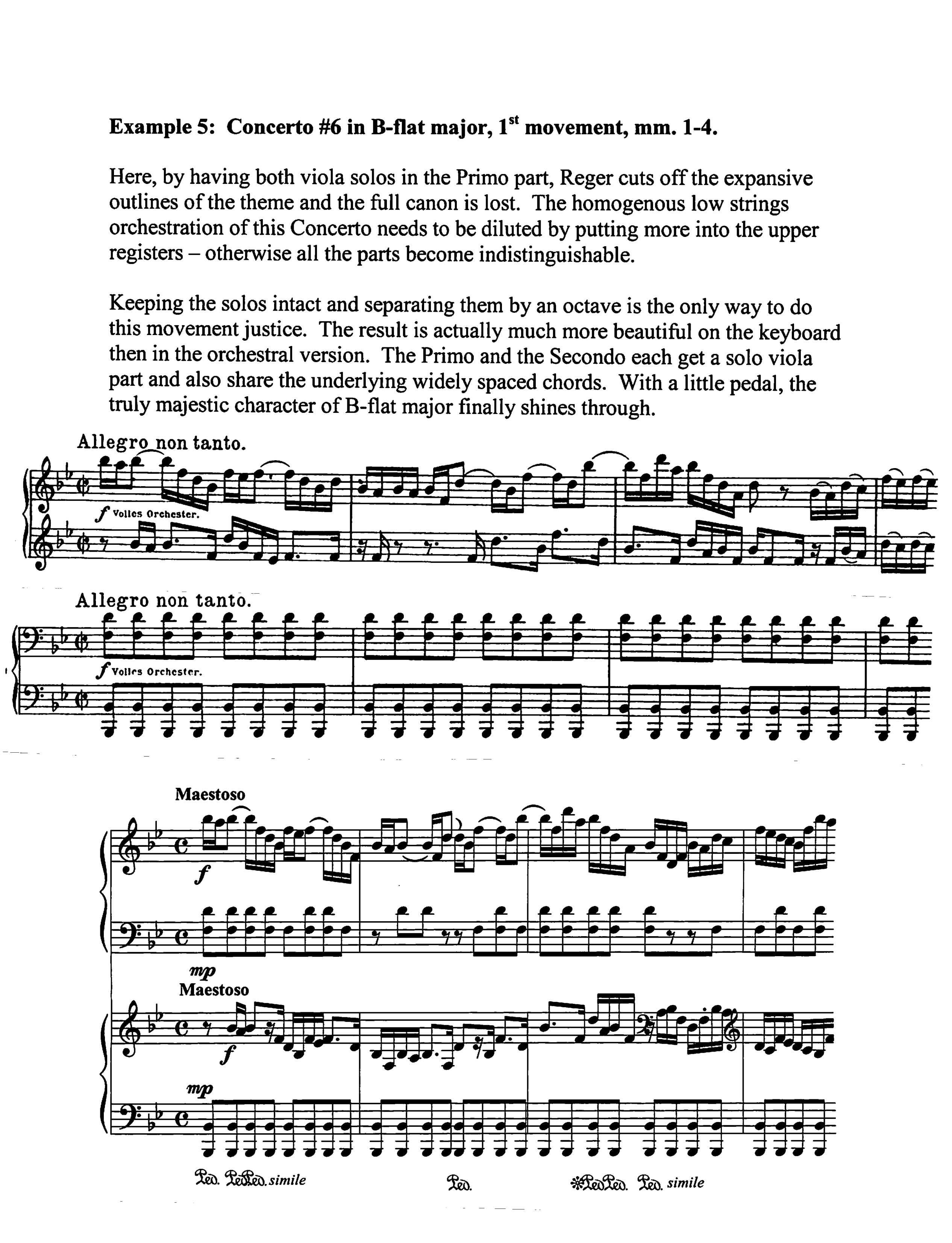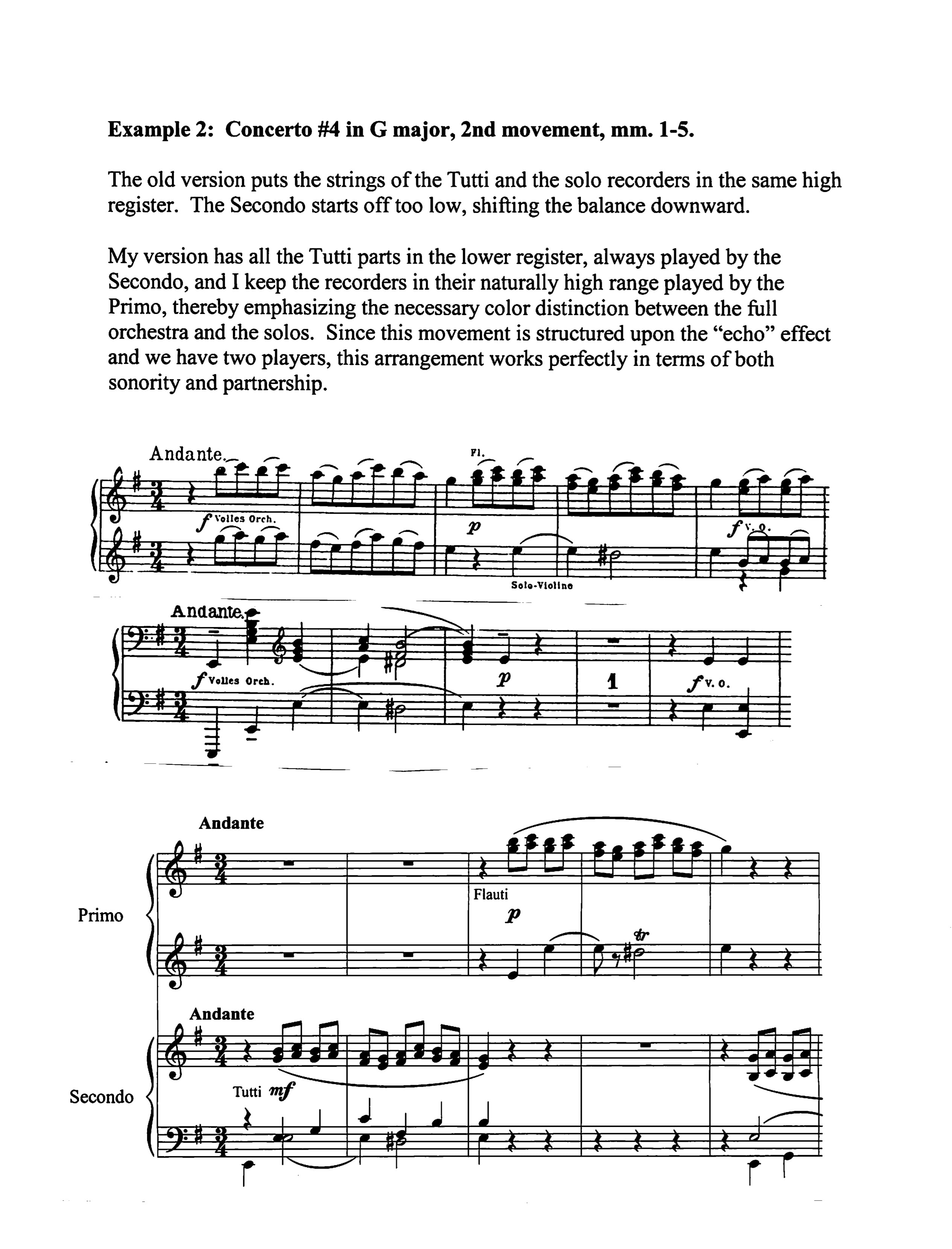The only previously existing piano duet arrangement of the Brandenburg Concertos by Max Reger is a very “literal” interpretation of the material. He tried to fit as many notes from the score as possible onto the 4 staves, without regard for thematic continuity, polyphonic clarity, instrumental color/differentiation, 4-hand logistics, or balance. There are three main flaws in his approach:
- The Primo part is too dense and unplayable up tempo while the Secondo part is too sparse so the partnership in music-making is dramatically unequal: boredom at the bottom and frustration on top.
- There is no clarity of the counterpoint: all the parts of the upper registers are clustered in the Primo, so they can be isolated neither by the ear nor by the eye.
- Conversely, due to consistent doubling of the cello/bass part in octaves, the sonority is too heavy on the bottom of the keyboard.
My solutions for the challenges are as follows:
- Secondo stops doubling and gains more thematic importance.
- The texture of Primo is simplified, leaving the counterpoint intact
- Incidental parts are eliminated for overall balance and clarity.
- The particular instrumentation of each Concerto is now carefully considered, highlighting the horn solos in #1, conveying the brightness of strings and trumpet in #2, finding clear canonic entrances among the strings in #3, setting the harpsichord apart from the strings and recorders in #4, letting the Primo and Secondo share the difficult harpsichord solo in #5 and separating the problematic viola canon in #6.
- The possibilities of the 4-hand idiom are fully explored, with thematic exchanges, tutti/solo contrasts and occasional hand-crossings which make duet playing so enjoyable.





The following excerpts (click to see full screen) illustrate typical issues with the existing arrangement by Max Reger. My improvements are shown at the bottom. Learn more about the process in the booklet notes from my 2018 Brandenburg Duets release.
My main goal was to create a transcription which highlighted the polyphony, imagining how Bach might have distributed the score if he intended to create 4-part inventions for Piano Duet. Doubling the cello/bass part in octaves, as Reger did, made no sense because it kept both hands of Secondo occupied and resulted in excessively bottom-heavy sonorities. Likewise, throwing all of the treble parts together in the Primo – violins, violas, oboes, solo french horns, flutes or trumpet plus the harpsichord – rendered the part unplayable at any decent tempo and hid the counterpoint in clusters of chords. To return to Baroque sensibilities, the individual lines had to be clear to the eye of the performer in order to be clear to the ear of listener. Since the fast movements of the Concertos usually have at least 4 voices intertwining and because more than 3 voices in polyphony become harmony in effect, some incidental parts could be omitted without any harm done to the integrity of the music. Using the Freiburg Baroque Orchestra’s “chamber” sound as a point of reference, i was able to restore the hierarchy and balance of the parts. At the same time, secondary string lines which may not be clearly audible in the orchestral version now sounded more distinctl on the keyboard. This approach helped give Bach’s magnificent texture the desired clarity for an elegant new translation.
Equal partnership of the pianists was another vital need in conveying the nature of Bach’s material and it resulted naturally from the polyphonic approach discussed above. In a Concerto Grosso, the sound should be fused in the Tutti sections and divided into threads for the solos. When different instruments, such as the flute and the violin, have simultaneous solos, we have no trouble hearing two voices. On the keyboard, however, the easiest way to give the lines different expression is to assign them to different people. The Piano Duet medium presents equally effective possibilities of either blending or differentiating the sound each performer produces. In the present arrangement, Secondo is always given an opportunity to fully indulge in beautiful melodic lines and the Duet partners execute frequent hand-crossings and other logistical adjustments which go with the piano-4-hands territory and make the collaborative experience even more enjoyable. These thematic exchanges enhance the momentum of the slower movements, as in the Andante of Brandenburg Duet #1 where Secondo takes the lead in the sublime oboe and violin duet.
